Life
Peak of activity will be earlier, satellites may fall to Earth: scientists announce changes in the Sun
Our Sun has its own cycles of activity, reaching its peak once every 11 years. The cycle looks like this: after the next surge, the activity is at a minimum for 6 years, and then there is a rise that lasts almost half the cycle. There are many powerful solar flares and coronal mass ejections (plasma emissions into space). And now scientists have announced that the current cycle may be anomalous.
According to IFL Science, calculations show that the peak of activity may not occur in 2025, but a year and a half earlier. The study was authored by Scott McIntosh of the US National Centre for Atmospheric Research. He has been studying the Sun's activity for a long time.
He and his colleagues have concluded that the 11-year cycle of the luminary's activity is directly related to the star's magnetic field. At the moment when it reaches its peak, the Sun's magnetic poles are reversed. This process is accompanied by the appearance of a large number of spots on its surface - areas with a very strong magnetic field. This is where solar flares and coronal mass ejections occur.
Meanwhile, McIntosh suggests that for a more accurate prediction of solar activity, we should take into account the Gale cycle, which is the combination of two 11-year cycles of the Sun. During this time, the star manages to change its magnetic poles twice.
According to the researcher, the Gale cycle contains special periods when more sunspots appear and they do not always coincide with the predicted solar maximum. McIntosh explained that in this case, sunspots begin to form closer to the middle of a typical solar cycle at a latitude of approximately 55 degrees in both hemispheres of the Sun, after which they begin to move towards the equator of the star and disappear.
Recent studies show that solar activity is currently higher than predicted. That's why scientists expect it to peak earlier than the forecast period. The 25th solar cycle, which began in 2019, is currently underway. It was supposed to peak in 2025, but updated data show that the Sun will change its magnetic poles in 6-12 months. That is, the surges are expected this year or early next year.
Astronomers do not expect absolutely catastrophic consequences, but the period will still be difficult. The number of spots on the Sun will grow and the number of plasma emissions will increase accordingly. During such events, particles travel through space at a high speed and, once they enter the Earth's atmosphere, cause geomagnetic storms.
Researchers warn that these outbreaks will be very powerful and will last for several months. The storms that will occur will also be strong and will cause bright northern lights, along with radio communication interruptions, problems with navigation systems and negative phenomena in power systems. In particular, there is a risk that satellites in Earth's orbit may begin to fail and even fall to our planet.
Earlier, OBOZREVATEL told you what scale of catastrophe will occur when our galaxy crashes into Andromeda.
Subscribe to OBOZREVATEL's Telegram and Viber channels to keep up with the latest news.



























